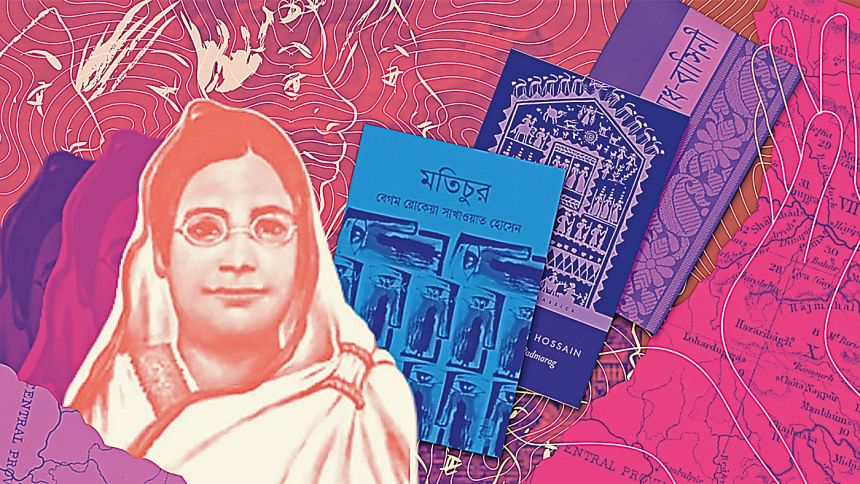Celebrating Rokeya

Rokeya Sakhawat Hossain (1880–1932) was exceptional in many different ways. Born on December 9, 1880, in a sleepy village in Rangpur, undivided Bengal, she died on the same day, 52 years later, in colonial Calcutta. Despite being born into great wealth, she was denied formal education by her rather notorious zamindar father, known for his gambling, wining, and whoring. Had it not been for her brothers, Rokeya would have remained illiterate all her life, like many of the Muslim women of her generation. However, during her lifetime, Rokeya became so famous that her untimely death was mourned by the dignitaries of colonial India at Albert Hall in Calcutta. Even almost a century after her death, her social contributions are discussed and celebrated on both sides of Bengal.
Her accomplishments make one wonder how she managed to achieve so much in the relatively short span of her life. After all, for Rokeya, it was an uphill struggle from the start: struggle to learn Bangla and English surreptitiously, struggle to find her own feet in Bhagalpur amongst her hostile in-laws, struggle to get on with a much older and ailing husband, struggle to survive after being evicted from her late husband's house in Bihar, struggle to find a foothold in Calcutta, struggle to run her school for Muslim girls against financial odds and social disapprobation, not to mention her struggle to make peace with her long and painful widowhood. Other people in her place probably would have given up much earlier in trying to fix a world that seems to have terribly gone wrong. After all, the money she was left with by her late husband would have allowed her to spend the rest of her life sitting at home and doing nothing. But Rokeya was not one of the wasteful kinds. She used her small fortune for the advancement of female education in colonial Bengal.
In many respects, Rokeya could be compared with Vidyasagar (1820-1891), that great Bengali pundit, writer, and social reformer who dominated the social, cultural, and literary life of Calcutta. Rokeya was only a 10-year-old girl, domiciled in East Bengal, when Vidyasagar died as a Calcutta luminary, but like Vidyasagar, Rokeya's life also reached its full potential in Calcutta. When faced with the insurmountable task of legalising Hindu widow marriage, Vidyasagar adopted a multi-pronged strategy. He found out evidence for widow marriage in Hindu religious scriptures, wrote about widow marriage as a social ill that required urgent attention, publicised the case of Hindu widows among his fellow Bengalis, launched a signature campaign to petition the British administration, and used his influence as a public intellectual to have widow marriage legalised by the British. Vidyasagar was a writer, intellectual, activist, and social reformer all rolled into one. Much like her celebrated predecessor, Rokeya also took recourse to a range of methods for the upliftment of women. Rokeya wrote to create social awareness about women's condition in India, reached out both to her friends and foes to win their support for her school, battled social prejudices, and put on a brave face when things did not go her way. Some of her contemporaries saw her as a Madonna, some as a monster, but nothing could deter her from trying to achieve women's emancipation through education.
Rokeya wrote on a plethora of subjects. Besides her now-classic Sultana's Dream (1908), in which she contemplated a female utopia, she published two volumes of essays titled Matichur (1904, 1922), a novel called Padmarag (1924), and Abaradhbasini (1931), a collection of short articles based on her real-life experience of observing Indian women living in seclusion. In a literary career stretching just over two decades, her output might be meagre in quantity but profound in its overall impact on subsequent generations of readers, scholars, feminists, and social reformers. During this period, Rokeya's views on various social and religious issues also went through a myriad of changes. Those who cite Rokeya's endorsement of the burka tend to overlook her vigorous questioning of the very tenets of religion. Those who take comfort in her Anchal-clad portrait often forget that Rokeya's attitude towards religion was highly ambivalent. Her writings on religion that came out in contemporary journals were considered to be hard meat by many, prompting Rokeya not to republish them in Matichur. Just as Vidyasagar strategically used his connections with the British administration to have widow marriage legalised, Rokeya also made a strategic use of religion to achieve women's emancipation.
In my view, Rokeya was far more of a radical thinker than what she has been made out to be, especially after her death. A real tribute to her could only be paid by reading her work in its entirety so that the various shifts in her positions could be better understood and her zeal for social reform appreciated. Her writings have survived a century because they document the issues that still plague the lives of millions of women around the world.
Manmay Zafar is Associate Professor of English at Jahangirnagar University. He was educated at Dhaka, Queensland and Oxford universities. Email him at [email protected].

 For all latest news, follow The Daily Star's Google News channel.
For all latest news, follow The Daily Star's Google News channel. 









Comments